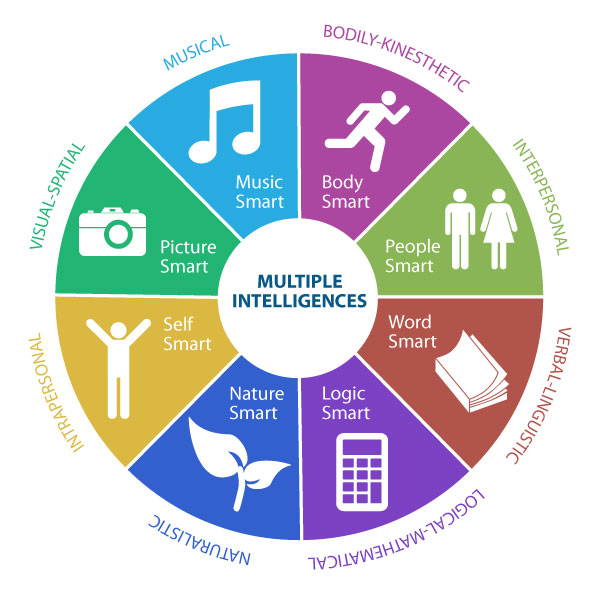In any TESOL classroom, students bring a range of learning styles, strengths, and preferences. The theory of Multiple Intelligences, proposed by Dr. Howard Gardner, suggests that intelligence goes beyond traditional linguistic and logical-mathematical abilities, encompassing various ways of learning and understanding. For TESOL teachers, recognizing and applying these intelligences can create a more engaging and inclusive environment where each student’s strengths are valued.
This guide explores how TESOL teachers can use Gardner’s Multiple Intelligences to enhance their lessons, along with practical activities tailored to each intelligence type.
What Are the Multiple Intelligences?
Dr. Gardner’s theory outlines eight primary types of intelligence:
- Linguistic – Strength in language use, reading, and writing.
- Logical-Mathematical – Skills in reasoning, problem-solving, and numbers.
- Visual-Spatial – Ability to visualize concepts and understand spatial relationships.
- Bodily-Kinesthetic – Preference for physical activity and hands-on learning.
- Musical – Sensitivity to sounds, rhythm, and music.
- Interpersonal – Skill in understanding and interacting with others.
- Intrapersonal – Self-awareness and ability to self-reflect.
- Naturalistic – Appreciation of the natural world and understanding of natural patterns.
By incorporating these intelligences into lesson plans, TESOL teachers can reach a broader spectrum of learning styles and engage students more fully.
Activities for Each Intelligence in the TESOL Classroom
Here’s how you can integrate each type of intelligence into language teaching, along with practical activities for implementation.
1. Linguistic Intelligence
Teaching Approach: Since TESOL learners are already focused on language, linguistic intelligence is naturally incorporated into most lessons. Use reading, writing, and word-based activities to strengthen this intelligence.
- Activity: Creative Writing Prompts
Give students story starters or prompts to encourage free writing. For example, ask them to describe their favorite place or imagine a day in a new city. This builds vocabulary, grammar, and language fluency. - Activity: Debate Club
Organize a friendly debate where students use persuasive language to express their opinions. Topics could include favorite hobbies, cultural topics, or light-hearted current events.
2. Logical-Mathematical Intelligence
Teaching Approach: For students who prefer structure and logic, incorporate pattern-based activities, problem-solving, and reasoning exercises.
- Activity: Grammar Puzzles
Use puzzles like crosswords or grammar sorting activities, where students arrange sentences correctly or fill in blanks. These exercises strengthen grammar skills and logical reasoning. - Activity: Class Surveys and Graphing
Have students conduct mini-surveys on topics like favorite foods or hobbies, then compile and analyze the results. This reinforces vocabulary related to data, numbers, and comparisons.
3. Visual-Spatial Intelligence
Teaching Approach: For visual learners, use images, mind maps, and graphic organizers. Visual aids make language concepts more concrete and memorable.
- Activity: Mind Mapping Vocabulary
Introduce new vocabulary by creating mind maps, where students connect words with images or related terms. This visual organization aids retention and understanding. - Activity: Storyboarding
Use storyboards to help students plan and tell a story. Ask them to sketch scenes and add captions. This approach is great for visualizing grammar structures, narrative flow, and vocabulary.
4. Bodily-Kinesthetic Intelligence
Teaching Approach: Incorporate movement and physical activities. Hands-on learners benefit from activities that let them engage physically.
- Activity: Role-Playing Scenarios
Set up scenarios, such as ordering food at a restaurant or asking for directions, where students can act out conversations. This practice helps build confidence in speaking. - Activity: Simon Says with Prepositions
For practicing prepositions of place, play a game of “Simon Says” using instructions like “Simon says put your hand above your head.” It’s fun and reinforces spatial vocabulary.
5. Musical Intelligence
Teaching Approach: Use rhythm, songs, and audio elements to appeal to students with musical intelligence.
- Activity: Song Lyric Gap Fill
Choose a popular English song, provide lyrics with missing words, and have students listen and fill in the blanks. This helps with listening skills, pronunciation, and vocabulary. - Activity: Rhythm Games for Pronunciation
Teach sentence stress and intonation using rhythm clapping games. Have students clap along to the rhythm of sentences to feel the natural stresses in English.
6. Interpersonal Intelligence
Teaching Approach: Group activities and collaborative projects work well for students with strong interpersonal skills.
- Activity: Peer Interviews
Have students pair up to interview each other on topics like hobbies or family life, then share what they learned with the class. This builds conversation skills and fosters connections. - Activity: Group Story Creation
In groups, ask students to create a story collaboratively. Each student adds a line, building on what the last person said. This activity encourages teamwork, listening, and creativity.
7. Intrapersonal Intelligence
Teaching Approach: Encourage self-reflection and journaling. Give students time to connect language learning with personal experiences.
- Activity: Daily Journal
Ask students to keep a simple journal where they write about their day or thoughts in English. This allows them to practice writing while reflecting on their experiences. - Activity: Goal-Setting Exercise
Have students set personal language goals, such as “Learn 5 new words a day.” Revisit these goals periodically, helping students track their progress and stay motivated.
8. Naturalistic Intelligence
Teaching Approach: Use nature-related themes and outdoor activities. Engage students with content about animals, weather, and environmental topics.
- Activity: Nature Vocabulary Walk
If possible, take students outside and name plants, trees, or other natural elements in English. If not, bring in images or videos related to nature and discuss them in class. - Activity: Environmental Debates
Discuss environmental topics, like recycling or protecting wildlife. Encourage students to research a topic and present their arguments in a structured debate.
Creating a Multi-Intelligence Classroom
To apply multiple intelligences in the classroom:
- Vary Your Activities: Incorporate different types of activities each week, ensuring that all intelligences are engaged over time.
- Observe and Adapt: Notice which activities resonate most with individual students and adjust your approach to cater to their strengths.
- Encourage Self-Awareness: Help students recognize their own learning preferences. When students understand their strengths, they can use them more effectively.
Final Thoughts
Using Multiple Intelligences in TESOL teaching helps create an inclusive, engaging, and effective learning environment. By acknowledging and catering to diverse learning styles, TESOL teachers can help each student find joy and confidence in learning English. Whether it’s through song, storytelling, or hands-on activities, applying Multiple Intelligences encourages deeper, more meaningful learning—making English language acquisition accessible and enjoyable for everyone.
Diversify the learning with technology! These free web tools and apps have various features and functions to provide students with choices in how they present their learning.



